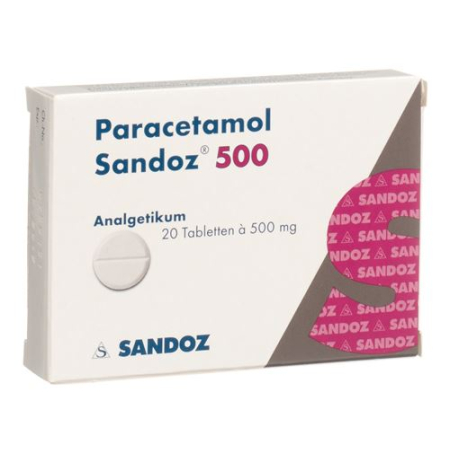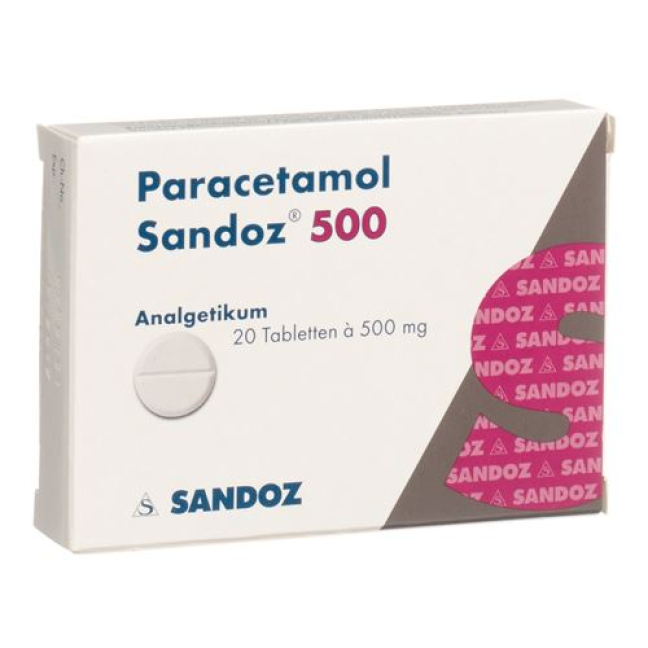Paracetamol Sandoz Tabl 500 mg 20 pcs
-
6.76 USD

- Availability: Outstock
- Brand: SANDOZ PHARMACEUTICALS AG
- Product Code: 5549305
- ATC-code N02BE01
- EAN 7680630480019
Description
What is Paracetamol Sandoz 500 mg and when is it used?
Paracetamol Sandoz 500 mg contains the active substance paracetamol, which has an analgesic and antipyretic effect.
It is used for the short-term treatment of headaches, toothache, joint and ligament pain, back pain, menstrual pain, pain after injuries (e.g. sports injuries), pain from colds and fever.
What precautions should be taken?
Like all fever and painkillers, Paracetamol Sandoz should not be used for more than 5 days in adults and children over 12 years of age or for more than 3 days in children up to 12 years of age without a doctor's prescription. If you have a fever, Paracetamol Sandoz should not be used for more than 3 days without a doctor's prescription.
Painkillers should not be taken regularly over a long period of time without medical supervision. Long-lasting pain requires a medical evaluation.
In case of high fever, signs of secondary infection or persistence of symptoms for more than three days, the doctor should be consulted.
The dosage specified or prescribed by the doctor must not be exceeded.
To prevent the risk of overdose, it should be ensured that other medicines taken at the same time (e.g. other painkillers, medicines for fever or cold symptoms) do not contain paracetamol. An overdose of paracetamol can lead to severe liver damage.
It is also important to remember that long-term use of painkillers can itself contribute to headache persistence.
Long-term use of painkillers, especially when several painkillers are combined, can lead to permanent kidney damage with the risk of kidney failure.
When not to take Paracetamol Sandoz 500 mg?
You must not take Paracetamol Sandoz 500 mg in the following cases:
- Hypersensitivity to the active ingredient paracetamol and related substances (e.g. propacetamol) or to one of the excipients (see “What does Paracetamol Sandoz 500 mg contain?”). Such hypersensitivity manifests itself, for example, in asthma, shortness of breath, circulatory problems, swelling of the skin and mucous membranes or skin rashes (nettle fever).
- In severe liver diseases (eg acute hepatitis, liver cirrhosis, ascites, ie accumulation of fluid in the abdominal cavity).
- In case of alcohol overconsumption.
- If you have a hereditary liver disorder (so-called Meulengracht disease).
When is caution required when taking Paracetamol Sandoz 500 mg?
You should consult your doctor before taking:
- with previously damaged kidneys or liver;
- if you have a rare inherited disease of the red blood cells called “glucose-6-phosphate dehydrogenase deficiency”;
- concomitant use of medicines that affect the liver, namely certain medicines for tuberculosis and seizure disorders (epilepsy) or medicines containing the active substance zidovudine, which are used in immunodeficiency (AIDS);
- if you are taking the following medicines:
- Blood thinning medicines (e.g. Marcoumar);
- cholestyramine (medicine to lower blood lipids);
- chloramphenicol (used to treat infections);
- metoclopramide (medicine for nausea, vomiting);
- phenytoin, phenobarbital, carbamazepine (medicines for epilepsy (seizures));
- rifampicin, isoniazid (medicines for tuberculosis);
- probenecid (gout medicine);
- zidovudine (medicine for HIV infection (AIDS)).
- if you have a severe infection (e.g. blood poisoning);
- if you are underweight or malnourished;
- if you consume alcohol regularly.
It is not advisable to take paracetamol and alcohol at the same time. The risk of liver damage increases, especially if you do not eat at the same time. Individuals who are hypersensitive to painkillers or antirheumatic drugs may also be hypersensitive to paracetamol (see «What side effects can Paracetamol Sandoz 500 mg have?»).
In very rare cases, paracetamol can cause severe skin reactions. If skin reactions occur, use of Paracetamol Sandoz 500 mg tablets should be discontinued and a doctor consulted (see «What side effects can Paracetamol Sandoz 500 mg have?»).
Paracetamol Sandoz 500 mg has no influence on the ability to drive and use machines.
Nevertheless, caution is always required after taking a painkiller.
Tell your doctor, pharmacist or druggist if you suffer from other illnesses, have allergies or are taking other medicines (including those you bought yourself!) or using them externally.
Can Paracetamol Sandoz 500 mg be taken during pregnancy or while breastfeeding?
As a precaution, you should avoid taking medicines during pregnancy and breastfeeding or ask your doctor, pharmacist or druggist for advice.
Based on previous experience, there is no known risk for the child with short-term use of the active ingredient paracetamol in the specified dosage.
Although paracetamol occurs in very small amounts in breast milk, breastfeeding is allowed.
How do you use Paracetamol Sandoz 500 mg?
The specified maximum daily dose must not be exceeded. Do not administer single doses more frequently than every 4-8 hours.
Adults and adolescents over 40 kg (over 12 years): 1-2 tablets up to 4 times a day (max. 8 tablets a day).
Children 30-40 kg (9-12 years): 1 tablet up to 4 times daily (maximum 4 tablets per day).
Children 22-30 kg (6-9 years): ½-1 tablet up to 3 times a day (maximum 3 tablets per day).
Children 15-22 kg (3-6 years): ½ tablet up to 4 times a day (max. 2 tablets a day).
Swallow tablets with ½ glass of liquid.
Follow the dosage given in this leaflet or as prescribed by your doctor. If you think the medicine is too weak or too strong, talk to your doctor, pharmacist or druggist.
In the event of uncontrolled intake (overdose), seek medical help immediately, even if you do not yet have any symptoms. Because of the potential risk of severe liver damage, prompt medical attention is critical. Nausea, vomiting, abdominal pain, loss of appetite or a general clinical picture can be an indication of an overdose, but only occur several hours to a day after ingestion.
What side effects can Paracetamol Sandoz 500 mg have?
The following side effects can occur when taking Paracetamol Sandoz 500 mg tablets: in rare cases, hypersensitivity reactions such as itching, swelling of the skin and mucous membranes or rashes up to severe skin reactions (very rare), nausea, shortness of breath or asthma. If signs of a hypersensitivity reaction or bruising/bleeding occur, the drug should be discontinued and the doctor consulted. In addition, changes in the blood picture, such as a severe reduction in the number of certain white blood cells (agranulocytosis) or a reduced number of blood platelets (thrombocytopenia) have been observed.
If you notice any side effects that are not described here, you should inform your doctor, pharmacist or druggist.
What should also be noted?
The medicinal product may only be used up to the date marked “EXP” on the container.
Keep below 30°C and out of the reach of children.
Paracetamol can cause interference in blood glucose measurements using the glucose oxidase method.
Drugs containing the active ingredient paracetamol must not be given to children who have accidentally consumed alcohol.
Your doctor, pharmacist or druggist can provide you with further information. These people have the detailed information for specialists.
What does Paracetamol Sandoz 500 mg contain?
1 tablet contains 500 mg paracetamol as an active ingredient as well as excipients.
Registration Number
63048 (Swissmedic).
Where can you get Paracetamol Sandoz 500 mg? What packs are available?
In pharmacies and drugstores, without medical prescription:
Boxes of 20 tablets.
In pharmacies, only with a prescription:
Boxes of 100 tablets.
Marketing Authorization Holder
Sandoz Pharmaceuticals AG, Risch; Domicile: Red Cross.





